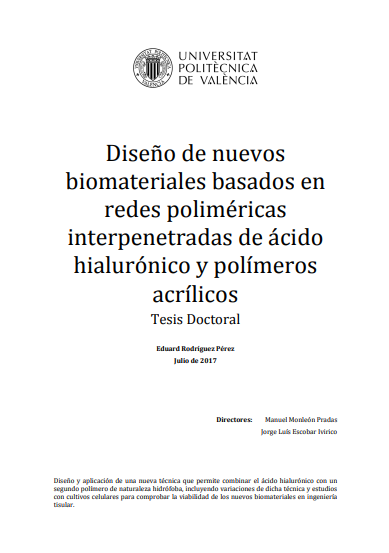Diseño de nuevos biomateriales basados en redes poliméricas interpenetradas de ácido hialurónico y polímeros acrílicos
Licencia: Creative Commons (by-nc-nd)
Autor(es): Rodríguez, Eduard
Hyaluronic acid (HA) is an essential molecule in the development of many tissues in the organism, as well as in their regeneration. Although, its physicochemical properties greatly limit its use as a cell support material in clinical applications unless its chemical structure is modified or is accompanied by other molecules. In this thesis a tridimensional scaffold has been made consisting of hyaluronic acid and a second material, an acrylic polymer (poly[ethyl acrylate] or PEA) able to be polymerized by free-radical polymerization inside HA after lyophilisation. The resultant interpenetrating polymer network (IPN) has been analyzed in order to measure its properties and compare them to similar scaffolds made from the two separate polymers, with the aim to compare the effects produced by the synthesis technique in the physical and chemical properties of HA. The viability of these materials in cell applications has been tested through in vitro assays using L929 fibroblasts. Additionally, several modifications have been made to the initial synthesis technique in order to obtain different proportions from the two components - HA and PEA - in the materials. The properties of these IPNs have been measured to reveal the effects produced by every step along their synthesis. The biomaterials produced though the techniques described here may offer interesting systems for cell culture and/or cell transplants in future clinical applications that wish to incorporate hyaluronic acid in the shape of a stable tridimensional scaffold.
[Valencia: 2017]
Compartir:
Una vez que el usuario haya visto al menos un documento, este fragmento será visible.


